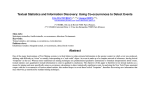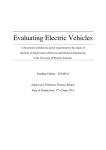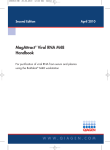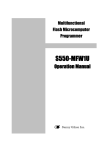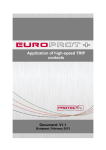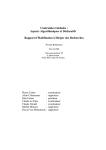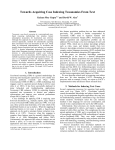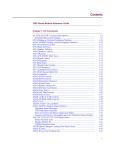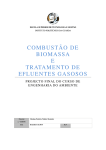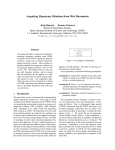Download Text categorization using lexical chains
Transcript
Text categorization using lexical chains
Tue Haste Andersen
Supervisor: Laszlo Bela Kovacs
Department of Computer Science,
Copenhagen University
February 28, 2000
Abstract
In this report I present a prototype system for use in dynamic text categorization research.
The system implements lexical chaining, as described in recent literature. On top of this
is built a simple extension to use for automatically identifying one or several categories to
place a given text in. The initial tests presented in this report does not give any useful
results, however, it give rise to new questions and possible directions for future research
of lexical chaining and its uses in text categorization. Along with the implementation,
previous research and the lexicographic database WordNet are discussed.
Keywords: Text categorization, dynamic, lexical chaining, WordNet, text retrieval.
1
Contents
Introduction
3
1 Background
5
1.1 WordNet . . . . . . . . . . .
1.2 Previous research . . . . . .
1.2.1 Text Retrieval . . .
1.2.2 Text Categorization
.
.
.
.
.
.
.
.
.
.
.
.
.
.
.
.
.
.
.
.
.
.
.
.
.
.
.
.
.
.
.
.
.
.
.
.
.
.
.
.
.
.
.
.
.
.
.
.
.
.
.
.
.
.
.
.
.
.
.
.
.
.
.
.
.
.
.
.
.
.
.
.
.
.
.
.
.
.
.
.
.
.
.
.
.
.
.
.
.
.
.
.
.
.
.
.
.
.
.
.
.
.
.
.
. 6
. 8
. 8
. 10
2 Categorization
11
3 Implementation
16
2.1 Lexical chaining . . . . . . . . . . . . . . . . . . . . . . . . . . . . . . . . . . 11
2.2 Categorization . . . . . . . . . . . . . . . . . . . . . . . . . . . . . . . . . . 14
3.1
3.2
3.3
3.4
3.5
3.6
Accessing the WordNet database
Morphologic analysis . . . . . . .
Lexical chainer . . . . . . . . . .
Lexical chain linker . . . . . . . .
Front-end . . . . . . . . . . . . .
Testing . . . . . . . . . . . . . .
.
.
.
.
.
.
.
.
.
.
.
.
.
.
.
.
.
.
.
.
.
.
.
.
.
.
.
.
.
.
.
.
.
.
.
.
.
.
.
.
.
.
.
.
.
.
.
.
.
.
.
.
.
.
.
.
.
.
.
.
.
.
.
.
.
.
.
.
.
.
.
.
.
.
.
.
.
.
.
.
.
.
.
.
.
.
.
.
.
.
.
.
.
.
.
.
.
.
.
.
.
.
.
.
.
.
.
.
.
.
.
.
.
.
.
.
.
.
.
.
.
.
.
.
.
.
.
.
.
.
.
.
.
.
.
.
.
.
.
.
.
.
.
.
16
17
18
19
19
20
4 Discussion
22
Bibliography
24
A Source code
26
B Test results
48
2
Introduction
Categorization is of importance when large amount of information needs to be stored in
some way, for later retrieval. Examples of uses are categorization of books and articles,
web pages, email messages and message routing. Today it is of growing importance to nd
good ways to do this automatically, as the amount of information available electronically
is growing fast.
Automatic categorization of text can be done in many ways, depending on the use of the
categorized texts. Below is listed three approaches, grouped by what kind of information
is available prior to categorization:
Pre-categorized texts. If pre-categorized material is available, it is possible to deduce
simple, yet fast and eective rules, to use for categorizing new material of same type.
Studies in rule induction have been done by Quinlan [Qui96] and Cohen [Coh95a]
primary focusing on eciency, in terms of speed.
Semantic networks. When a semantic network relating word to actions, concepts, etc.,
is available, material can be categorized in a number of ways, relying on the network.
User model. In a system based on a user model, it is possible to use the information
collected about the users behavior, preferences etc., for categorizing data. This
approach could be made far more dynamic than that of the rule induction.
In this report, I will focus on a browsable hypertext system, similar to those present on
Internet portals like the \WWW virtual library"1. Here the presented links are selected
and categorized by humans. Therefore it will be necessary to employ more people to nd,
select and categorize the information, as the Internet grows. If part of this process could be
automated, enormous amounts of resources could be saved. It might be dicult to make a
system that ensures high quality in the selected documents, but to categorize documents
automatically seems more reasonable, because a complete knowledge of the documents is
not required. Instead a rather coarse grained view of the topics present in the documents
will do.
1
http://vlib.org/
3
The categories on a typical Internet portal are stored in a hierarchy or network structure of topic labels. Today documents are manually placed in these categories, and the
whole structure of category labels is also extended manually. The problem is therefore
not only to assign a predened label to a given document, but also to place a document
into a hierarchy or network of topic labels, and to extend this structure whenever needed.
For this purpose, the semantic network approach mentioned above, can provide the necessary background information. The fact that such background information bases are
public available, makes it possible to rapidly develop systems that can be used for experimentation on real life data. Furthermore, the learning phase is not limited to symbol
manipulation of known data, as is the case of the two other examples mentioned above
(in the rst case pre-categorized texts; in the user model, recorded user actions.)
In the following chapters I will proceed by introducing background information on
the lexicographic database WordNet2 , along with an overview of research in text retrieval
problems. This is followed by a description of the theory of lexical chaining, which is used
to disambiguate meanings of words, as represented in WordNet. Finally a method for
categorizing texts is presented, along the implementation of the prototype system3 and
experiments, showing initial results. The main goal is to examine if a good method for
text categorization using lexical chaining can be found, and to test the usability of the
lexical chaining technique in practice.
2
3
WordNet can be downloaded from http://www.cogsci.princeton.edu/~wn/
The system will soon be made available for download from http://www.diku.dk/students/
haste/textcat/
4
Chapter 1
Background
The system described in this project heavily relies on a lexicographic database, called
WordNet [Fel98]. Other databases are available which contains information about language and semantics, but WordNet is unique in that it covers a large part of the target
language, English, and has well dened concepts and relations.
Another database that probably contains more information than WordNet, is Cyc
available from Cycorp1 . However, this database has been criticized for not being wellstructured, and therefore dicult to use in text retrieval problems [KMF96]. In [KMF96]
it is demonstrated that a number of problems exists when Cyc is used in the solving of
classic text retrieval problems. These includes:
Incomplete and non-uniform coverage of knowledge concepts. WordNet has also
been criticized for incomplete coverage, but has a uniform structure, where Cyc
lacks selectional constraints on the knowledge.
Inecient accessibility of knowledge, because the whole database has to be searched
to nd everything about a given concept.
There are other electronically available ontologies including Pangloss, Mikrokosmos
and EDR [KMF96]. However, none of these have as wide coverage of a language as
WordNet or Cyc.
Among other, these are the reasons why I have chosen to base this project on WordNet.
In this chapter I will give an overview of what WordNet contains, and how it is structured.
Secondly I will present an overview of the eld of text retrieval in the context of text
categorization.
1
See http://www.cycorp.com/
5
Word
Synset id Synset gloss
Orange 103880945 Any of a range of colors between red and yellow.
105783752 Round yellow to orange fruit of any of several
citrus trees.
109007985 Any citrus tree bearing oranges.
110758147 Any pigment producing the orange color.
Table 1.1: Example of the synsets representing the dierent senses of the word \Orange."
1.1 WordNet
In WordNet every word is represented by a set of synonyms, called synsets (see table
1.1.) Each synonym represents a meaning of the word. Each synset have a unique id,
most of them have a gloss phrase assigned to them, which is some informal English text,
describing the meaning of the synonym. But apart from this phrase, the synonyms are
dened in terms of links to other synsets. This means that the information in WordNet
is build around sets of synonyms, as they are the primary keys to represent the semantics
of words.
Figure 1.1 shows a search on the word \orange" in WordNet. In the left window we
see that the word both can be used as an adjective, and as a noun. Furthermore it shows
dierent types of links to the word { E.g. following \... is a kind of orange (hyponyms)",
will show the synsets which are specialization's of orange. The right window shows the
four dierent senses found of the word, and displays the gloss phrase associated with each.
A number of dierent relations exist between synsets in WordNet. They are listed
in table 1.2, along with their type. A semantic relation means that the relation holds
between meanings of words (more specically, synsets), and a lexical relation means that
its between word forms, not meanings of words.
The most important relation of table 1.2 is synonymy. Of other important relations
represented in WordNet is antonymy, which is a lexical relation describing relations between words of opposite meaning, e.g. ascend and descend are antonyms. Hyponymy and
hypernymy is a semantic relation describing a hierarchy between word meanings. Here
tool is a hypernym of fork, and fork is a hyponym of tool. Meronymy and holonymy can be
described by the has-a or part-of relation: E.g. a motor is part of a car, therefore motor is
a meronym of car and car is a hypernym of motor. In WordNet the actual representation
of the car-motor relation, consists of several intermediate levels: motor is a hypernym of
engine, which is a hypernym of automobile engine, which is a part meronym of car. Furthermore meronymy is divided into three types of relations in WordNet, namely member,
6
7
Figure 1.1: Screen shot from WordNet TreeWalk showing a search on \Orange." WordNet
TreeWalk is available for download from http://www.ac-toulouse.fr/wordnet/
Name
Abbreviation
Type Word forms
Attribute
at
Semantic Adjectives-nouns
Synonymy
sim
Semantic Adjectives
ant
Lexical
Antonymy
Hyponymy/Hypernymy
hyp
Semantic Nouns and verbs
Meronymy/Holonymy mm,ms,mp Semantic Nouns
Entailment
ent
Semantic Verbs
sa
Lexical Adjectives and verbs
See also
Cause
cs
Semantic Verbs
ppl
Lexical Verbs-adjectives
Participle
Pertain
per
Lexical Adjectives-adverbs,
adjectives-nouns
Group
vgp
Semantic Verbs
Table 1.2: Relations in WordNet. The column \Abbreviation" show the relation names,
as they are called in the Prolog distribution of the WordNet database les. \Type" shows
the type of relation, and \Word Forms" tells possible constraints on which word forms the
relation holds between.
substance and part meronymy.
An ER diagram of WordNet is show in gure 1.2. Even though the participle relation
connects verbs and adjectives, it only consists of 90 relations. This makes it dicult to use
all the information stored in WordNet, because of this weak connection between dierent
syntactic categories.
1.2 Previous research
1.2.1
Text Retrieval
In Information Retrieval, many underlying techniques have been tried on a wide variety
of applications. Most commons are models based on symbol manipulation [Yan99, MSS].
This type of models relies on a correlation between words as symbols and their meaning,
which only to some extend is present. In other words, the models do not take into account the dierent meanings of the words, which also is reected in the results of their
performance.
The problem of text retrieval is traditionally viewed as matching a query string against
a set of texts, and thereby nding the documents that are relevant to the query [Voo98].
One common way of doing this is by using a vector space model [Voo98]. Here each text
8
Nouns
at
Verbs
per
Adjectives
ppl
per
Adverbs
Figure 1.2: ER diagram showing relations between dierent syntactic categories in WordNet.
is represented by a T -dimensional vector, where T is the number of dierent words in the
text. The length of the vector in a given direction, is given by the number of times a
particular word occurs in the text. Given a query, the vector for that query is calculated,
and matched against each vector of the text collection. Now only the text vectors that
are similar to the query vector, is returned as results. Obvious advantages of using simple
symbol-based approaches like this are:
They are fast, robust, and well-known [Coh95a, Coh95b, Qui96].
They can be made general, i.e. they do not need supervised conguration for use in
dierent areas [MSS].
The biggest disadvantage of this kind of model, is that no better than half of the
searched documents can be found. The best results of this kind of model, has achieved
to nd about half of the relevant documents. Using a precision/recall evaluation scheme,
this means that no more than 50% of the found articles of a test set is in fact relevant,
and no more than 50% of the truly relevant documents are found [Voo98].
A way to enable the vector space model to take into account the dierent senses of
words, is to apply WordNet for resolving the senses of the Words. George Miller has done
exactly that, by adding a new WordNet construct called a hood [Voo98]. The idea is to
assign a number of categories to each word, and then to disambiguate the categories, so
only one is left for each word. The category labeling is dened by the hood, which itself
9
is dened by the hyponymy relation. A hood is the synset that the word synset is a
descendant of, as long as no other relations exists from the hood and down to the word
synset. By assigning and disambiguating hoods automatically, the vector space model can
be applied on the hood categories instead of the word symbols.
Unfortunately the results are at best, no better than the symbol based approach. For
this reason I have chosen to base the developed system on another technique for automatic
word sense resolution, namely lexical chains.
1.2.2
Text Categorization
In the previous section a system using hoods derived from WordNet as categories was
discussed. These category labels was used for matching queries against texts, to nd
documents related to the query. The prototype system I am developing, is to be used for
a category browsing system, which is quite dierent from the use of the hoods. Finding
a hood of a word or synset does not indicate anything about the structure or the context
the word is used in.
An attempt to use WordNet and lexical chaining for categorization, is Al-Halimi and
Kazman's lexical trees [AHK98]. These trees are build in a manner like lexical chains, but
instead of nding several chains, only one is build, preserving a tree structure between the
words.
Another algorithm is QUESCOT by Stairmand [Sta97] also based on lexical chains.
The chains are identied using Morris and Hirst's algorithm, but a new additional concept
is introduced, namely lexical clusters, which should correspond to the context at xed
points in the analyzed documents. Here they dene context as \context can be specied
by a word set consisting of keywords of the context." This is done by considering the
distribution of the terms found in the lexical chains throughout a document. It is assumed
that there exists a tight relation between the contexts in the document, and the main topic.
Therefore the most dominant context is selected as the topic of the document.
A system for categorization of email messages is described in [Tak95]. It is not based
on WordNet, but describes a dynamic system, based on the semantic distance of the
documents in a given category. When the distance becomes too big, the category is split
into several sub categories. In this way the system is able to extend its structure while
adding new documents. Unfortunately the paper only covers a preliminary study.
10
Chapter 2
Categorization
As the eld of automatic categorization is very limited on published research, I have
chosen to select techniques successfully applied to other applications of text retrieval,
namely lexical chaining. I have then made some initial experiments on how to use it for
text categorization.
The general idea is rst to identify all lexical chains by using an adapted version
of Morris and Hirst's original algorithm [MH91, SO95]. Hereafter I will try to identify
relations between the found chains, to nd out which are general/specic in meaning.
Finally it may be possible to place the article in one or several sub categories, see gure
2.1.
I will start with a description of lexical chaining, and then continue with how the
identied chains can be used for categorizing text.
2.1 Lexical chaining
The lexical chaining algorithm was developed by Morris and Hirst. The algorithm group
the words of a given text, so that the words of each group has a close semantic relation.
The purpose of the algorithms was to correctly disambiguate meanings of words, but also
to give an indication of the text structure [SO95]. Because chains are limited in scope,
they tend to indicate the structure of the text [MH91]. However, as stated by Stairmand,
it is not clear whether or not there is a relation between the identied chains and the
concept of text structure [Sta97].
The algorithm was developed by Morris and Hirst [MH91] based on Roget's International Thesaurus, which is a classication of words and phrases into ideas and concept.
However, at the time of development, Roget's was not available electronically, and therefore the algorithm was never implemented. This was later done by St-Onge [SO95, HSO98]
and Stairmand [Sta97], both adapted for WordNet.
11
Text
Inference engine
Information and
knowledge:
Lexical chainer
WordNet
Chains
Lexical linker
Linked
Chains
Category heirarcy
Categorizer
Figure 2.1: Overview of the prototype system. The lexical chainer and linker are the
modules that are already developed, and presented in section 3.
St-Onge's algorithm is based on the original algorithm, along with the notion of
salience, which was introduced by Okumura and Honda (see [SO95] for further reference.) Salience means that both recency and length of a chain is taken into account when
building chains.
The algorithm works by looking up a word at a time, and then try to establish relations
between the word and one of the chains. The relations can either be between the word
symbols, or the synsets assigned to the words.
- Read word
- Skip word if found in stop list.
- Find semantically equal term in WordNet, by performing
morphologic analysis
- Find relation between word and one of the words in the
already initialized chains.
- If none is found, make a new chain, and initialize it with
the new word.
- If relation is found, disambiguate synset senses of words
in chain, by pruning all senses not used to find the
relations between the words.
This continues until no more words is available. To use the salience concept, the chains
12
are searched in order of recency, i.e. the read word, is compared to the words in the chains
most recently updated. If a chain has not been updated according to a special threshold
value, the chain is not updated any more. Finding relations between words is done by
applying one of several rules, each assigned a weight. Here each relation in WordNet has
been given a direction, see table 3.1.
Extra strong The words are equal.
Strong There exists one or more direct horizontal relations between the synsets of the
two words.
Medium A relation can be made using the following rules:
The number of relations between the two synset pairs must be no greater than
ve.
No more than one change in direction is allowed, unless it is horizontal.
Upward relations is only allowed if no other direction changes has been made
before.
The medium relations are further weighted, by their length and number of changes in
direction. When a relation is found, synsets that are not directly connected to other synsets
in the chain are pruned. In this way disambiguation is done incrementally whenever new
words is added, and more information about what senses of the words is available.
As mentioned earlier, it can be dicult to make tight relations between lexical chains
and other semantic entities. The word disambiguation might be coarse grained, but
still lexical chaining has many useful purposes in information retrieval. Compared to
other methods in this eld, lexical chaining has with success been applied to detection
of malapropisms [HSO98], and also initial experiments in categorization has been applied
[Sta97].
St-Onge's implementation is based on version 1.4 of WordNet. The most important
dierence between this version and version 1.6, at least when lexical chaining is considered,
is that the 1.4 lacks relations between verbs and nouns. This lead St-Onge to limit the
analysis to nouns { When a word was found that could not be looked up in WordNet's
noun database it was skipped. With the use of version 1.6 it may therefore be possible to
improve performance of the output.
Another aspect of the algorithm is the running time { It is not discussed in the literature
I know of. It is important when comparing application based on other IR methods, also to
compare the running time. Many of these tools are used where large amount of information
needs to be processed, and therefore the performance matters. The issue is discussed in
section 3.3 and 3.6.
13
2.2 Categorization
The idea is to match lexical chains against a network of categories. As an example this
could be the network of categories you can browse through at Yahoo's portal. Instead of
representing the nodes by words the system should use synsets from WordNet.
When the chains of a document has been identied, they can be matched against the
category network in several ways (see gure 2.2):
Find relations between chains and category nodes. Hereafter try to nd a path in
the matched categories, and thereby selecting the one that is semantically close to
the text.
Find a path of relations between chains, and then search for a similar path in the
category network.
Both methods gives the possibility to add new categories to the network. This can be
done whenever a chain cannot be matched against a node in the network. Of course it is
not a trivial process to connect the chain to the right nodes in the network.
A way to examine weather this is a good idea or not, could be to extract the category
networks from e.g. Yahoo or the Open Directory Project1 , and then search for links between the categories. The lexical chaining implementation from this system could easily
be adapted for this use. In this way it may be possible to discover properties of the relational structure in the network. This information could then be used to insert new nodes
automatically.
However, due to time limitations, I have chosen to do another test. By implementing
the lexical linker from gure 2.1, it will be possible to examine if links between the chains
can be found. However, since the lexical chainer already have found relations between the
words of the individual chains, the relation paths between chains are probably exhibiting
a dierent structure. In the prototype system I will allow longer path, and path only
containing upward or horizontal directions. In this way, I hope to nd a path which have
some resemblance to a category hierarchy.
1
See http://www.yahoo.com and http://dmoz.org respectively.
14
Chains with relations
Category network
c1
c2
c3
c4
c6
c5
c8
c7
Figure 2.2: The categorization system surrounding the lexical chaining and linking system
is searching for a path in the category hierarchy similar to the one found between the
chains. An alternative could be to nd relations between chains and category labels, and
hereafter search for a path through the identied labels.
15
Chapter 3
Implementation
The prototype system implements the following components:
Database access to WordNet.
Morphologic analysis
Lexical chainer
Lexical chain linker
Front-end
The system is developed in Sicstus Prolog [Swe98], using the Object Prolog extension of
Sicstus. Object Prolog is an object oriented extension of the Edinburgh dialect of Prolog.
Object Prolog is very similar to Prolog++ [Swe98]. The reason why I choose to develop
the system in Object Prolog is primary because the description of the lexical chaining
made by St-Onge relied on object oriented concepts. Futhermore I wanted to develop a
program in an object oriented extension to Prolog, as I have never tried this before.
The source code for the lexical chainer developed by St-Onge and Stairmand is not
public available. My implementation is primary based on [SO95], although some relations
used in the chaining process might be dierent. The following description of the implementation is primary discussing implementation details, only important for the developed
system.
3.1 Accessing the WordNet database
WordNet is distributed both as databases with native browsing interfaces for Windows,
Unix and MacOS, and as Prolog readable les. I used the Prolog distribution for this
16
project, along with some les from the native distribution which were not included in the
Prolog distribution. The total size of the les are about 19 Mb. To load and compile
this, requires heavy computation. To avoid this I converted the les to external Prolog
database les. In this way the programs using the database loads faster, and I could easily
adjust the indexing mechanism to my needs.
The convert program relies on the les from the WordNet distribution to be available
in the same directory as the program runs from. Also some of the les from the native
distribution requires preprocessing, before they can be read by the converter program.
For accessing the WordNet database from Prolog, I have written a static class called
wordnet, appendix A. References to the databases are opened when the le containing
the class denition is loaded. The class contains two specialized methods:
dbc
This method takes as argument a WordNet relation (see table 1.2 for predicate names)
and instantiates its parameters.
Given a word, returns a list of valid synset for that particular word. If the word
cannot be found in the database, the method fails.
synsets
Furthermore it contains template descriptions and denitions of the relations used in
lexical chaining.
3.2 Morphologic analysis
Morphologic analysis is in general divided in two dierent processes [Cov94]:
Inection which is the processes of transforming between dierent forms of a word,
and
Derivation which is a transformation between words of dierent syntactic categories.
For practical implementation purposes, it is always a tradeo, of how much you want
to list in the dictionary, and how much should be handled by a program. In the case of
English, there are many regular inections of words, and therefore it would be possible to
write an inection algorithm that can handle a large part of the morphologic transformation. On the other hand it would be hard to cover all inections without listing some of
them in lexicon. For example, there is no rule telling that the plural of child is children
[Cov94].
The front-end of the native distribution of WordNet, handles the problem by doing
inection, and if that fails it tries to look the word up in a list of irregular word forms. This
list is not supplied in the Prolog distribution, but I have chosen to convert the les from
17
the native version to Prolog, and then implementing my own inectional transformation
system. This is done in the morph object. Sending a checkword message to the morph
object with a word as input, instantiates the second parameter with the same word, but
in a possible dierent form, which can be found in the WordNet database. validate is
used by checkword to ensure that the derivation can be found in WordNet's noun index.
Furthermore it searches for compound words, and transform words from upper to lower
case when needed.
3.3 Lexical chainer
The lexical chainer is implemented using the two dynamic classes chain and lexchain.
When used, lexchain fetches a sentence at a time, and then try to add each word to one
of the chains. The lexical chaining is done in chain and lexchain, by performing the
morphologic analysis on the words, and allocating chain objects, containing the actual
chains. By sending an add message to a chain object, the object responds by either
accepting the word, or failing. If it fails the lexchain object backtrack and tries another
chain object. If no chain will accept the word, a new chain is created, by sending a new
message to the chain class.
The implementation diers from St-Onge's, in the way medium strength relations are
found. Instead of nding all of them, then calculating a weight, and selecting the optimal,
I perform a breath rst search to nd the relation with shortest path rst. When the rst
relation is found it is selected, and the search is not continued.
The disambiguation is done in chain by rst removing superuous relations between
synsets prune synrel/2, and then removing the unconnected synsets, prune synsets/2.
The class uses assert and retract to store the relations between the words and synset.
As described in section 2.1 extra strong relations are sought throughout all chains
before seeking for strong or medium relations. Therefore the running time must at least
be O(N log N ) where N is the size of the text. Strong and medium relations are only
sought in a limited scope of chains. However, as will be seen from the next section, a
typical analysis have one or two longer chains, which continues to be updated throughout
the whole analysis. Therefore the running time of the strong and medium analysis will
probably be somewhere near to that of the extra strong search. It is quite dicult to give
an average time analysis, since it depends on which of the WordNet relations is used for
constructing the medium relation search.
18
Name
Antonymy
Attribute
Cause
Entailment
Group
Holonymy
Hypernymy
Hyponymy
Meronymy
Participle
Pertain
See also
Synonymy
Direction
Horizontal
Horizontal
Down
Down
Horizontal
Down
Up
Down
Up
Horizontal
Horizontal
Horizontal
Horizontal
Table 3.1: Directions assigned to the WordNet relation, as it is done by St-Onge.
3.4 Lexical chain linker
The linking of the identied chains is done in the lexlink class. The process is very
similar to what is done in the chain class, only the relation types allowed is dierent.
Each synset of a chain is matched against the synsets of the other chains using the
relation method. relation is only allowed to use upward or horizontal links to nd a
path between the two synsets. The path must be no longer than ten relations.
It is important to note that the object identity of both the lexchain and the chain
classes are of crucial importance for its success. Both classes use value assignment by
specialized version of the get/set predicates. Another solution could be to pass the
object values as parameters to the objects in a frame-like manner. This would keep the
declarative semantics intact, but instead it might be confusing to keep passing long lists
of parameters between the objects.
3.5 Front-end
The front-end consists of the predicate test. The article to be analyzed should be placed
in the le article.pl before loading. The system gives a progression indication while
searching for the chains, and nally prints out the chains and their interrelations.
19
No Heading
1 China warns Taiwan about making
two states theory legal
2 Bananas - Cultural directions
3 Tae kwon do
Source
No./words
CNN (web), Jan. 31. 2000
383
From www.plants.com
Encyclopedia Britannica,
1999 electronic edition
330
224
Table 3.2: The table show the four articles used in the testing of the developed prototype.
3.6 Testing
The testing of the system is done by applying three dierent articles as input to the system.
A description of the articles are show in table 3.2. The results is printed in appendix B.
An initial test of the chainer was rst done using the following words: Pear, apple,
carrot, melon, tree, apples, blue, red, green and yellow. Here we would expect two chains
as result, one containing fruits and vegetables, and one containing colors. In fact the result
is:
[apple,melon_tree,carrot,apple,pear]
[yellow,green,red,blue]
Furthermore we see that the morph class seems to work in that the word 'apples' has
been transformed to 'apple', and 'melon' and 'tree' has been made a compound word.
Looking at the chains produced from the example texts, also shows that the words of the
chains have good relations to each other.
However, the most crucial parameter for its success, I have found to be which relations is used. In the tests presented here I have restricted the analysis to the use
of meronymy/holonymy, hypernymy/hyponymy and antonyms. When trying to include
some of the other upward/downward relations, the search time was dramatically increased,
without any better results. Also when trying to relax the constraints of the use of horizontal relations it was found that only one or two chains was found, containing words
without any close semantic relations. These experiments indicate that the restrictions on
the medium strength relation search, is of crucial importance for the algorithms success.
The results of the experiments shows that a number of lexical chains is found for each
article. In all three tests one chain grows very big (covers about 30% of the article).
However the words in the chains are all naturally related somehow. It is of course not an
objective measure, weather my personal opinion is that they are naturally related or not.
A better measure could be to make a large number of English speaking persons group the
20
words of the documents. By comparing the results with the lexical chains found by the
developed system, a better measure of its success may be found.
Applying the lexical linker to the chains found for each article, showed that no relations
between the chains could be found. In the lexical linker it is allowed to construct chains of
length 10. However, if it is not at all possible to construct chains of that length using the
selected relations, it is likely that no relations is found. This is because relations of length
5 have already been sought when constructing the chains. This problem could maybe be
solved by using other relations than in the chaining process. An examination of which
ones should be used, along with which constraints could be a possible continuation of this
project.
21
Chapter 4
Discussion
Compared to the traditional ways of analyzing natural language, the use of lexical chains
can be described as a hackers approach. Instead of trying to analyze a whole sentence by
some predened rules, everything which immediately can be assigned a meaning is used,
and everything else is thrown away. The structure of sentences is not considered and only
nouns are used. However, as the testing of the prototype system shows, the model is in
fact quite robust, identifying words of similar meaning. In text categorization, the only
thing of interest is to assign one, maybe two labels to the text, thereby placing it in a
network of category labels. For this purpose, it is not needed to understand every single
sentence of the text to be analyzed. Instead the rather coarse grained view of the lexical
chains might be adequate.
An interesting property is the chaining algorithm's ability of specialization when analyzing a text. A text describing animals, humans, and plants, may be able to place all
these references in the same chain, whereas a document describing humans in one context
and animals in another, may be able to distinguish these things by placing the words in
dierent chains. Although not tested here, this should be possible because of the dynamic
word sense resolution. In other words this means that a system based on this resolution
mechanism can be applied to many dierent areas without further adaption, because it is
able to set a level of detail.
The system show robustness in the quality of output, but another aspect is the running
time. As discussed in the tests the result is dependent on the number of relations used
to nd medium strength relations. However, I believe the running time can be reduced
by better knowledge, on which combinations is likely to give a valid relation, and also the
inclusion of verbs in the analysis. To give a better understanding of which paths are worth
searching for, a statistical analysis could be performed.
The lexical linking process, is obvious not a success in its present implementation.
However, I believe that experiments on nding relations in an existing category network,
22
will give more insight to what constraints should be used, when searching for relations
between chains. But a better lexical linker is not the only thing that is needed. Also a
matching against the existing network is not a trivial process to implement. This part
should preferably also include feedback to the category network, in form of added categories.
An overall view of the subject shows that there are great possibilities in a database
like WordNet, covering a wide variety of the English language. Although extension of the
database is needed to include better connections of the dierent syntactic categories, more
knowledge on how to use these relations is also needed. The developed prototype makes
it possible to investigate these properties of WordNet. I think that what is done today
using lexicographic databases like WordNet, is only the top of the iceberg. By using a
system based on e.g. lexical chaining, I believe it is possible to make advanced language
based interfaces, without a complete knowledge on the theory of natural language.
23
Bibliography
[AHK98] Reem Al-Halimi and Rick Kazman. Temporal indexing through lexical chains.
In Fellbaum [Fel98], chapter 14, pages 333{351.
[Coh95a] William W. Cohen. Fast eective rule induction. In Machine Learning: Proceedings of the Twelfth International Conference, 1995.
[Coh95b] William W. Cohen. Text categorization and relational learning. In Machine
Learning: Proceedings of the Twelfth International Conference, 1995.
[Cov94] Michael A. Covington. Natural Language Processing for Prolog Programmers.
Prentice Hall, 1994.
[Fel98]
Christiane Fellbaum, editor. WordNet: An Electronic Lexical Database. MIT
Press, 1998.
[Hir00]
Graeme Hirst. Context as a spurious concept. In Alexander F. Gelbukh, editor,
CICLing-2000, pages 273{285, 2000.
[HSO98] Graeme Hirst and David St-Onge. Lexical chains as representations of context
for the detection and correction of malapropisms. In Fellbaum [Fel98], chapter 13, pages 305{332.
[KMF96] Jim Cowie Kavi Mahesh, Sergei Nirenburg and David Farwell. An assessment
of cyc for natural language processing. Technical Report MCCS-96-302, Computing Research Laboratory, New Mexico State University, 1996.
[MH91] J. Morris and Graeme Hirst. Lexical cohesion computed by thesaural relations
as an indicator of the structure of text. Computational Linguistics, 17(1):21{48,
1991.
[MSS]
Marti Hearst Mehran Sahami and Eric Saund. Applying the multiple cause
mixture model to text categorization. ?, ?
24
[Qui96] J. R. Quinlan. Learning rst-order denitions of functions. Journal of Articial
Intelligence Research, (5):139{161, 1996.
[SO95]
David St-Onge. Detecting and correcting malapropisms with lexical chains.
Master's thesis, Department of Computer Science, University of Toronto, 1995.
[Sta97]
Mark A. Stairmand. Textual context analysis for information retrieval. In
SIGIR, Philadelphia, 1997.
[Sti99]
Rune R. Stilling. Using natural language to search the internet. Master's thesis,
Computer Science, Roskilde University, 1999.
[Swe98] Swedish Institute of Computer Science. SICStus Prolog User's Manual, September 1998.
[Tak95] Juha Takkinen. An adaptive approach to text categorization and understanding
{ a preliminary study. Presented at the Fifth IDA Graduate Conference on
Computer and Information Science, Linkoping, November 1995.
[Voo98] Ellen M. Voorhees. Using wordnet for text retrieval. In Fellbaum [Fel98], chapter 12, pages 285{303.
[Yan99] Yiming Yang. An evaluation of statistical approaches to text categorization. ?,
1999.
25
Appendix A
Source code
File:
main.pl
% ==========================================================================
% Main file for the lexical chainer and linker system.
%
% By Tue Haste Andersen <[email protected]>, February 1999.
% Tested in Sicstus Prolog 3.7.1.
% ==========================================================================
?- use_module(library(objects)).
?- consult(util).
?- consult(wordnet).
?- consult(morph).
?- consult(article).
?- consult(sentence).
?- consult(chain).
?- consult(lexchain).
?- consult(lexlink).
test :lexlink::new(example),
example::print_chains.
26
File:
lexlink.pl
% ==========================================================================
% Part of the lexical chainer and linker system.
%
% By Tue Haste Andersen <[email protected]>, February 1999.
% Tested in Sicstus Prolog 3.7.1.
% ==========================================================================
lexlink :: {
super(lexchain) &
dynamic chain_rel/2 &
:- :use_module(library(ordsets), [list_to_ord_set/2, ord_member/2,
ord_del_element/3, ord_union/2]) &
new(Instance) :super <: new(Instance) &
:write('Linking...'), :nl,
Instance::get(chain_ids(X)),
Instance::chain_synsets(X,ChainSynsets),
Instance::find_chain_rel(ChainSynsets,ChainSynsets) &
% ------------------------------------------------------% Initiates the process of finding links between the
% lexical chains.
% ------------------------------------------------------find_chain_rel([],_) &
find_chain_rel([X|Rest],ChainSynsets) ::ord_del_element(ChainSynsets,X,C1),
:ord_union(C1,C2),
::synset_rel(X,C2),
::find_chain_rel(Rest,ChainSynsets) &
% ------------------------------------------------------% Succeeds if a relation exists between S1 and S2, where
% S1 is a synset of C1 and S2 is a synset of C2.
% ------------------------------------------------------synset_rel([],_) &
synset_rel([C|C1],C2) ::member(S1,C),
::relation(S1,S2),
27
:member(S2,C2),
:write('chain_rel '), :write(S1), :write(S2), :nl,
assert(chain_rel(S1,S2)) &
synset_rel([_|C1],C2) :::synset_rel(C1,C2) &
% ------------------------------------------------------% relation is true if there exists an upward link between
% the two synsets.
% ------------------------------------------------------relation(From,To) :::relation(From,To,[]) &
relation(From,To,Old) ::length(Old,L), :(L<10),
wordnet::direction(Type,Dir), :member(Dir,[up,horizontal]),
wordnet::link(Type,From,Temp,Pred),
wordnet::dbc(Pred),
(
Temp = To ;
::relation(From,To,[Temp|Old])) &
% ------------------------------------------------------% Given a list of chain id's, returns a list of ordered
% synset sets. Only sets of lengths greater than one are
% included in the output list.
% ------------------------------------------------------chain_synsets([],[]) &
chain_synsets([ID|R1],[S3|R2]) :ID::get(chain(S1)),
%
:length(S1,L), :(L > 1), !,
<:chain_extract_synsets(S1,S2),
:list_to_ord_set(S2,S3),
::chain_synsets(R1,R2) &
chain_synsets([_,R1],R2) :::chain_synsets(R1,R2)
}.
28
File:
lexchain.pl
% ==========================================================================
% Part of the lexical chainer and linker system.
%
% By Tue Haste Andersen <[email protected]>, February 1999.
% Tested in Sicstus Prolog 3.7.1.
% ==========================================================================
% ------------------------------------------------------------------------% The lexchain class implements the chaining of an article, by reading
% each sentence, and construct lexical chains.
% ------------------------------------------------------------------------lexchain :: {
super(object) &
:- :use_module(library(lists), [delete/3]) &
attributes([chain_ids([]), % ID's of all chains.
sentences([])])
& % ID's of all sentence objects.
new(Instance) :super <: instance(Instance),
Instance :: chainer &
% ----------------------------------------------------% Print out the values of the identified chains.
% ----------------------------------------------------print_chains :<: get(chain_ids(IDs)),
<: print_chains(IDs) &
print_chains([]) &
print_chains([X|Rest]) :X::get(chain(Y)),
<: chain_words(Y,Z),
:write(Z), :nl,
<: print_chains(Rest) &
% Given a chain list, with each element being [Word,Synsets],
% returns a list of [Word,No-of-synsets] elements.
chain_words([],[]) &
chain_words([[W,S]|R1],[[W,N]|R2]) :-
29
:length(S,N),
<: chain_words(R1,R2) &
% ----------------------------------------------------% Given a list of [Word,Synsets] pairs, returns a list
% of [Synsets] elements.
% ----------------------------------------------------chain_extract_synsets([],[]) &
chain_extract_synsets([[_,S]|R1],[S|R2]) :::chain_extract_synsets(R1,R2) &
% ----------------------------------------------------% Calls chainer/4 for each sentence in the article.
% ----------------------------------------------------chainer :sentence::get_words(SentenceNo,Words), !,
get(chain_ids(C1)),
<: chainer(Words,SentenceNo,C1,C2),
set(chain_ids(C2)),
<: chainer &
chainer ::write('Done.'), :nl &
% Given a list of valid sentence words, updates chains.
chainer([],_,C,C) &
chainer([Word|Rest],Sentence,Cin,Cout) ::write('Searching relation to '), :write(Word), :write(': '),
<: addword(Word,Sentence,Cin,ID), !, :nl,
:delete(Cin,ID,CTemp),
<: chainer(Rest,Sentence,[ID|CTemp],Cout) &
chainer([Word|Rest],Sentence,Cin,Cout) :!,
:write('fail. '),
chain::new(ID,Word),
:write('Creating chain '), :write(ID),
:write(', '), :write(Word), :nl,
<: chainer(Rest,Sentence,[ID|Cin],Cout) &
% ----------------------------------------------------% Given a word, sentence no, and a list of chain id's,
% addword tries to add the word to one of the chains.
30
% ----------------------------------------------------addword(Word,Sentence,Chain,ID) :<: addword(Word,Sentence,Chain,ID,extrastrong) &
addword(Word,Sentence,Chain,ID) :<: addword(Word,Sentence,Chain,ID,strong) &
addword(Word,Sentence,Chain,ID) :<: addword(Word,Sentence,Chain,ID,medium) &
addword(Word,Sentence,[ID|_],ID,RelationType) :ID::add(Word,Sentence,RelationType),
:write('found '), :write(RelationType),
:write(' to '), :write(ID), ! &
addword(Word,Sentence,[_|Rest],ID,RelationType) :<: addword(Word,Sentence,Rest,ID,RelationType)
}.
31
File:
chain.pl
% ==========================================================================
% Part of the lexical chainer and linker system.
%
% By Tue Haste Andersen <[email protected]>, February 1999.
% Tested in Sicstus Prolog 3.7.1.
% ==========================================================================
% ---------------------------------------------------------------% This class holds the words of a chain along with the relations
% between them.
% ---------------------------------------------------------------chain :: {
super(wordnet) &
dynamic word_rel/3 &
dynamic syn_rel/3 &
:- :use_module(library(lists), [member/2, non_member/2]) &
:- :use_module(library(ordsets), [list_to_ord_set/2,
ord_intersection/3]) &
attributes([chain([]),
% Chain, containing word id's
recency(0)]) & % Holds the sentence number of the most
% recent added word in the chain.
new(Instance,Word) :super <: instance(Instance),
<: synsets(Word,Synsets),
Instance :: set(chain([[Word,Synsets]])) &
% ------------------------------------------------------% Adds the word Word to the chain and returns the
% relation type for the added word.
% ------------------------------------------------------add(Word,SentenceNo,RelationType) :<: synsets(Word,Synsets),
get(chain(C1)), get(recency(RecencyNo)),
:member([W2,S2],C1),
<: relation(RelationType,RecencyNo,SentenceNo,[Word,Synsets],
[W2,S2],Rel), !,
32
% Update chain recency
chain_recency(RecencyNo,SentenceNo),
% Update chain
set(chain([[Word,Synsets]|C1])),
assert(word_rel(RelationType,Word,W2)),
assert_synrel(Rel),
prune_synrel(Word,W2),
prune_synsets([[Word,Synsets]|C1],C2),
set(chain(C2)) &
% ------------------------------------------------------% Updates the recency of the chain if necessary.
% ------------------------------------------------------chain_recency(RecencyNo,SentenceNo) ::(SentenceNo > RecencyNo),
set(recency(SentenceNo)) &
chain_recency(_,_) &
% ------------------------------------------------------% Given a word of chain, return associated synsets. This
% method differs from wordnet::synsets in that only the
% synsets which have not been removed by the word sense
% disambiguation is returned.
% ------------------------------------------------------chain_synsets(W,S) :get(chain(C)),
:member([W,S],C) &
% ------------------------------------------------------% Asserts a list of new syn_rel's.
% ------------------------------------------------------assert_synrel([]) &
assert_synrel([X|R]) :assert(X),
<: assert_synrel(R) &
% ------------------------------------------------------% Lookup a synset relation
% ------------------------------------------------------synset_rel(X,Y) :- <: syn_rel(_,X,Y) &
33
synset_rel(X,Y) :- <: syn_rel(_,Y,X) &
% ------------------------------------------------------% Retract synset relation
% ------------------------------------------------------retract_synset_rel(X,Y) :<: syn_rel(_,X,Y), retract(syn_rel(_,X,Y)) &
retract_synset_rel(X,Y) :<: syn_rel(_,Y,X), retract(syn_rel(_,Y,X)) &
% ------------------------------------------------------% When a chain is updated with new relations,
% prune_synsets is called to remove superfluous synsets.
% ------------------------------------------------------prune_synrel(W1,W2) :% Find a relation from W2 to W3, using a synset S2,
% which also connects W1 (S2a,S3a).
<: chain_synsets(W1,R1),
<: chain_synsets(W2,R2),
:member(S1a,R1),
:member(S2a,R2),
<: synset_rel(S1a,S2a),
<: chain_synsets(W3,R3), :non_member(W3,[W1,W2]),
:member(S3a,R3),
<: synset_rel(S2a,S3a),
% Find a relation between a synset in W2
% and W3 not connected to W1 (S2b,S3b)
:member(S2b,R2),
<:not((<:synset_rel(S1b,S2b), :member(S1b,R1))),
<: synset_rel(S2b,S3b), :member(S3b,R3),
% Ensure that another relation than (S2b,S3b)
% exists from W3.
: member(S3c,R3), <: synset_rel(S3c,Sx),
(
:(S3c \== S3b) ; :(Sx \== S2b) ),
% Delete (S2b,S3b)
<: retract_synset_rel(S2b,S3b), !,
% Try to find other relations
34
<: prune_synrel(W2,W3),
<: prune_synrel(W1,W2) &
prune_synrel(_,_) &
not(X) :- ((X, !, :fail) ; :true ) &
% ------------------------------------------------------% After prune_synrel, prune_synsets removes synsets with
% no relations to other synsets.
% ------------------------------------------------------prune_synsets([],[]) &
prune_synsets([[W,R1]|C1],[[W,R2]|C2]) :<: prune_synsets1(R1,R2),
<: prune_synsets(C1,C2) &
prune_synsets1([],[]) &
prune_synsets1([X|R1],[X|R2]) :<: syn_rel(_,X,_),
<: prune_synsets1(R1,R2) &
prune_synsets1([X|R1],[X|R2]) :<: syn_rel(_,_,X),
<: prune_synsets1(R1,R2) &
prune_synsets1([X|R1],R2) :<: prune_synsets1(R1,R2) &
% ------------------------------------------------------% Given two words with corresponding synsets, succedes if
% there is a relation between the two words, and return a
% list of synset relations of the form:
% rel(Weight,Synset_id1,Synset_id2).
% ------------------------------------------------------% The words are equal
relation(extrastrong,_,_,[W,_],[W,S],Rel) :<: relation_list(extrastrong,S,S,Rel), ! &
% The words share one or several synsets
relation(strong,RecencyNo,SentenceNo,[_,S1],[_,S2],Rel) ::(Temp is RecencyNo+7), :(Temp >= SentenceNo),
:ord_intersection(S1,S2,S3),
:(S3 \== []), !,
35
<: relation_list(strong,S3,S3,Rel) &
% Horizontal link exists between the two.
relation(strong,RecencyNo,SentenceNo,[_,S1],[_,S2],Rel) ::(Temp is RecencyNo+7), :(Temp >= SentenceNo),
<: relation_strong(S1,S2,Rel),
:(Rel \== []), ! &
relation_strong([],_,[]) &
relation_strong([S1|R1],R2,[syn_rel(strong,S1,S2)|Rel]) :<: direction(Type,horizontal),
<: link(Type,S1,S2,Pred),
<: dbc(Pred),
:member(S2,R2),
<: relation_strong(R1,R2,Rel) &
relation_strong([_|R1],R2,Rel) :<: relation_strong(R1,R2,Rel) &
% Medium-strenght relations
relation(medium,RecencyNo,SentenceNo,[_,S1],[_,S2],Rel) ::(Temp is RecencyNo+3), :(Temp >= SentenceNo),
<: relation_med(S1,S2,Rel),
:(Rel \== []), ! &
relation_med([],_,[]) &
relation_med([S1|R1],R2,[syn_rel(medium,S1,S2)|Rel]) :<: relation_med([[S1,[]]],R2,_,S2), !,
<: relation_med(R1,R2,Rel) &
relation_med([_|R1],R2,Rel) :<: relation_med(R1,R2,Rel) &
% Perform breath first search, to ensure that shortest
% path is found first!
relation_med(R1,R2,Path,S3) ::member([_,TestPath],R1), :length(TestPath,L), :(L < 5),
self(Self), :setof(S2, Self::breath_rel(R1,S2),Set), !,
(
(
:member(S3,R2), :member([S3,Path],Set)) ;
(
<: relation_med(Set,R2,Path,S3))) &
breath_rel(R1,[S2,[Dir|Path]]) ::member([S1,Path],R1),
<: analyze_path(Path,Type,Dir),
36
<: link(Type,S1,S2,Pred),
<: dbc(Pred) &
% Given a weight, two lists of synsets, returns a list of
% relations for the synsets.
relation_list(_,[],[],[]) &
relation_list(Weight,[S1|R1],[S2|R2],[syn_rel(Weight,S1,S2)|Rest]) :relation_list(Weight,R1,R2,Rest) &
% ------------------------------------------------------% analyze_path returns a valid relation type to apply to
% the given path (Type).
% ------------------------------------------------------analyze_path([],Type,Dir) :<: direction(Type,Dir) &
analyze_path(Path,Type,Dir) :<: upward_direction(Path),
<: direction(Type,Dir) &
analyze_path(Path,Type,Dir) :<: one_direction(Path),
<: direction(Type,Dir),
:(Dir \== up) &
analyze_path([Dir|_],Type,Dir) :<: direction(Type,Dir) &
analyze_path([horizontal|_],Type,down) :<: direction(Type,down) &
% ------------------------------------------------------% Ensures that the given path only contains upward
% directions.
% ------------------------------------------------------upward_direction([up]) &
upward_direction([up|Rest]) :<: upward_direction(Rest) &
% ------------------------------------------------------% Ensures that only one direction is taken in the given
% path.
% ------------------------------------------------------one_direction(Path) :<: one_direction(Path,_) &
37
one_direction([Dir],Dir) &
one_direction([Dir|Rest],Dir) :<: one_direction(Rest,Dir)
}.
38
File:
morph.pl
% ==========================================================================
% Part of the lexical chainer and linker system.
%
% By Tue Haste Andersen <[email protected]>, February 1999.
% Tested in Sicstus Prolog 3.7.1.
% ==========================================================================
% ------------------------------------------------------------------------% This class performs lookup in wordnet, by trying to make compound words,
% transform case from upper to lower, inflection and derivation.
% ------------------------------------------------------------------------morph :: {
super(object) &
:- :use_module(library(lists), [append/3]) &
% ----------------------------------------------------% Given a list of words, returns a term found in
% wordnet, and the rest of the words. The term is made
% by first concatenating the first three words of the
% list, the the two first, and finally the first. If
% none is found, the first word is ignored.
% ----------------------------------------------------get_next_word(List,Word,Rest) :<: compound_word(List,WordTemp,Rest),
<: checkword(WordTemp,Word), ! &
get_next_word(List,Word,Rest) :<: compound_word(List,WordTemp1,Rest),
:lower_case(WordTemp1,WordTemp2),
<: checkword(WordTemp2,Word), ! &
get_next_word([_|List],Word,Rest) :<: get_next_word(List,Word,Rest) &
% ----------------------------------------------------% Concatenation of terms, by the way described above.
% ----------------------------------------------------compound_word([X,Y,Z|Rest],Word,Rest) ::atom_concat(X,'_',T1),
:atom_concat(T1,Y,T2),
:atom_concat(T2,'_',T3),
:atom_concat(T3,Z,Word) &
39
compound_word([X,Y|Rest],Word,Rest) ::atom_concat(X,'_',T),
:atom_concat(T,Y,Word) &
compound_word([Word|Rest],Word,Rest) &
% ----------------------------------------------------% checkword, takes as input a noun, and transforms it
% into the baseform. If the predicate fails it is
% either because the input word is not a noun, or it
% was not identified as such.
% ----------------------------------------------------% Check the word as it is.
checkword(Word,Word) :<: validate(Word), ! &
% Try to look it up in the exception list, of irregular
% forms.
checkword(WordIn,WordOut) :wordnet::dbc(exc(noun,WordIn,WordOut)),
<: validate(WordOut), ! &
% Try morphing of word - remove "ful" ending before
% doing so.
checkword(WordIn,WordOut) :<: ending(WordIn,Base,ful),
<: morphword(Base,WordTemp),
<: ending(WordOut,WordTemp,ful),
<: validate(WordOut), ! &
% Try morphing words which is not ending on "ss".
checkword(WordIn,WordOut) :(
<: ending(WordIn,_,ss), !, :fail ) % Stop if word
;
(
% ends on ss.
<: morphword(WordIn,WordOut), % Otherwise try to morph
<: validate(WordOut), !) &
% Again, try morphing of word, by removing what is after
% possible "-" characters in the word.
checkword(WordIn,WordOut) :<: beforedelimeter(WordIn,WordTemp),
<: morphword(WordTemp,WordOut),
40
<: validate(WordOut), ! &
% ----------------------------------------------------% Succeds if the word is a noun represented in wordnet,
% and the word is not in the stoplist.
% ----------------------------------------------------validate(Word) :wordnet::dbc(stop(Word)), !, :fail &
validate(Word) :wordnet::dbc(s(_,_,Word,n,_,_)) &
morphword(WordIn,WordOut) :<: suffix(noun,EndOld,EndNew),
<: ending(WordIn,Base,EndOld),
<: ending(WordOut,Base,EndNew) &
suffix(noun,'s','') &
suffix(noun,'ses','s') &
suffix(noun,'xes','x') &
suffix(noun,'zes','z') &
suffix(noun,'ches','ch')&
suffix(noun,'shes','sh')&
ending(Word,Base,End) ::ground(Word), :ground(End),
:name(Word,WordList),
:name(End,EndList),
:append(BaseList,EndList,WordList),
:name(Base,BaseList) &
ending(Word,Base,End) ::ground(Base), :ground(End),
:name(Base,BaseList),
:name(End,EndList),
:append(BaseList,EndList,WordList),
:name(Word,WordList) &
beforedelimeter(WordIn,WordOut) ::ground(WordIn),
:name(WordIn,WordInList),
:append(WordOutList,['-'|_],WordInList),
:name(WordOut,WordOutList)
}.
41
File:
wordnet.pl
% ==========================================================================
% WordNet access for the lexical chainer and linker system.
%
% By Tue Haste Andersen <[email protected]>, February 1999.
% Tested in Sicstus Prolog 3.7.1.
% ==========================================================================
?- use_module(library(db)).
?- use_module(library(objects)).
databases([[s_db,s],[sim_db,sim],[ant_db,ant],[stop_db,stop],[exc_db,exc],
[mm_db,mm],[mp_db,mp],[hyp_db,hyp],[sa_db,sa],[at_db,at],
[per_db,per],[cs_db,cs],[ent_db,ent],[g_db,g],[ppl_db,ppl]]).
open_database :databases(DB),
open_database(DB).
open_database([]).
open_database([[DB,Name]|Rest]) :db_open(DB,read,_,Ref),
assert(db_ref(Name,Ref)),
open_database(Rest).
?- open_database.
% ---------------------------------------------------------------% wordnet is a static object containing methods for accessing the
% WordNet database in a convenient way.
% ---------------------------------------------------------------wordnet :: {
super(object) &
:- :use_module(library(lists), [non_member/2]) &
:- :use_module(library(ordsets), [list_to_ord_set/2]) &
% ------------------------------------------------------% DataBase Consult. Consults the given term in the
% associated external database.
% ------------------------------------------------------dbc(Term) ::functor(Term,Head,_),
:db_ref(Head,R),
42
:db_fetch(R,Term,_) &
% ------------------------------------------------------% Given a word, return a list of corresponding synsets.
% Fails if no noun synsets is found.
% ------------------------------------------------------synsets(Word,List) :<: synsets(Word,Temp,[]),
:length(Temp,X), :'>'(X,0),
:list_to_ord_set(Temp,List) &
synsets(Word,[Sid|Rest],Retreived) :<: dbc(s(Sid,_,Word,n,No,_)),
:non_member(No,Retreived), !,
<: synsets(Word,Rest,[No|Retreived]) &
synsets(_,[],_) &
% ------------------------------------------------------% Specifies a direction on each WordNet relation type.
% ------------------------------------------------------direction(ant,horizontal) &
%direction(at,horizontal) &
%direction(per,horizontal) &
%direction(sim,horizontal) &
%direction(sa,horizontal) &
%direction(per2,horizontal) &
direction(hyper,up) &
direction(mm,up) &
direction(ms,up) &
direction(mp,up) &
%direction(cs2,up) &
direction(hypo,down) &
direction(mh,down) &
direction(hs,down) &
direction(hp,down) &
%direction(cs,down) &
%direction(ent,down) &
% ------------------------------------------------------% Templates for different relation types. Instantiating
% R1 or R2 to a synset, returns a template for use
43
% with wordnet::dbc.
% ------------------------------------------------------link(sa,R1,R2,sa(R1,_,R2,_)) &
link(ant,R1,R2,ant(R1,_,R2,_)) &
link(at,R1,R2,at(R1,R2)) &
link(per,R1,R2,per(R1,_,R2,_)) &
link(per2,R1,R2,per(R2,_,R1,_)) &
link(sim,R1,R2,sim(R1,R2)) &
link(cs,R1,R2,cs(R1,R2)) &
link(cs2,R1,R2,cs(R2,R1)) &
link(ent,R1,R2,ent(R1,R2)) &
link(hyper,R1,R2,hyp(R1,R2)) &
link(hypo,R1,R2,hyp(R2,R1)) &
link(mm,R1,R2,mm(R1,R2)) &
link(mh,R1,R2,mm(R2,R1)) &
link(ms,R1,R2,ms(R1,R2)) &
link(hs,R1,R2,ms(R2,R1)) &
link(mp,R1,R2,mp(R1,R2)) &
link(hp,R1,R2,mp(R2,R1))
}.
44
File:
sentence.pl
% ==========================================================================
% Part of the lexical chainer and linker system.
%
% By Tue Haste Andersen <[email protected]>, February 1999.
% Tested in Sicstus Prolog 3.7.1.
% ==========================================================================
% ----------------------------------------------------------------------% Class holding the words of a sentence. When the object is created
% a sentence number is given as paramter. The words of the sentence
% is morphologically trasformed, and verified to be represented in the
% nuon index of WordNet. All the words satisfiying these conditions are
% stored in this object.
% ----------------------------------------------------------------------sentence :: {
super(article) &
attributes([number(0)]) & % Sentence number
get_words(Number,Words) :get(number(X)),
:(Y is X+1),
<: sentence(Y,SentenceWords),
(
(
<: normalize_words(SentenceWords,Words),
set(number(Y)),
Number = Y ) ;
(
set(number(Y)), get_words(Number,Words))) &
normalize_words([],[]) &
normalize_words(Words,[VerifiedWord|Rest2]) :morph::get_next_word(Words,VerifiedWord,Rest1),
normalize_words(Rest1,Rest2)
}.
45
File:
util.pl
% ==========================================================================
% Misc. predicates for the lexical chainer and linker system.
%
% By Tue Haste Andersen <[email protected]>, February 1999.
% Tested in Sicstus Prolog 3.7.1.
% ==========================================================================
% ---------------------------------------------------------------% This predicate is included in Sicstus 3.8, but to run the
% program under 3.7 it is needed.
% ---------------------------------------------------------------atom_concat(A,B,AB) :ground(A), ground(B),
name(A,Alist),
name(B,Blist),
append(Alist,Blist,ABlist),
name(AB,ABlist).
% ---------------------------------------------------------------% Converts the term T1 to a term T2, only consisting of lower
% cases.
% ---------------------------------------------------------------lower_case(T1,T2) :name(T1,Upcase),
convert_case(Upcase,Lowcase),
name(T2,Lowcase).
% ---------------------------------------------------------------% Given a list of character codes, convert those of upper case to
% lower case.
% ---------------------------------------------------------------convert_case([],[]).
convert_case([U|R1],[L|R2]) :U > 64, U <91,
% Verify that the char is uppercase.
L is U + 32,
convert_case(R1,R2).
convert_case([L|R1],[L|R2]) :convert_case(R1,R2).
46
File:
article.pl
% ==========================================================================
% Test data for the lexical chainer and linker system.
%
% By Tue Haste Andersen <[email protected]>, February 1999.
% Tested in Sicstus Prolog 3.7.1.
% ==========================================================================
?- use_module(library(objects)).
article :: {
super(object) &
name(einstein) &
sentence(1,[pear,apple,carrot,melon,tree,apples,blue,red,green,yellow])
}.
47
Appendix B
Test results
The following shows the found lexical chains for the three examples (see table 3.2.) For each word
the number of associated synsets is shown next to it. Because the example texts are copyrighted
they are not included here.
Title: Tae kwon do (running time: 54 minutes on Intel Pentium, 100MHz)
Chains:
[[martial_art,1],[tae_kwon_do,1],[tae_kwon_do,1],[martial_art,1],
[tae_kwon_do,1],[karate,1],[tae_kwon_do,1]],
[[contact,1],[short,1],[opponent,1],[sparring,1],[free,1],[practice,1],
[student,1],[attack,1],[sequence,1],[set,1],[sparring,1],[step,1],[id,1],
[combination,1],[sparring,1],[basic,1],[practice,1],[student,1],[grade,1],
[rank,1],[series,1],[development,1],[spiritual,1],[founder,1],[principal,3],
[general,1],[South_Korean,1],[defense,1],[form,1],[art,4],[art,4]]
[[blow,1],[counter,1],[punch,1],[kick,1],[jump,1],[standing,1],[combat,1],
[kicking,1]]
[[In,1]]
[[lower,1]]
[[proficiency,2]]
[[high,7]]
[[Korean,2],[Korean,2],[Korean,2]]
Title: China warns Taiwan about making two states theory legal
(Running time: 55 minutes on Intel Pentium II).
[[democracy,1],[mainland,1],[society,1],[formula,2],[Taiwan,1],
[capitalist,1],[run,1],[Beijing,1],[system,1],[country,1],[formula,2],
[China,1],[part,1],[Taiwan,1],[state,1],[back,1],[Taiwan,1],[policy,1],
48
[official,1],[leadership,1],[senior,1],[member,1],[people,1],[people,1],
[Taiwanese,1],[safety,2],[property,1],[life,1],[fire,1],[action,1],
[people,1],[prospect,1],[Taiwan,1],[constitution,1],[state,1],[force,1],
[Taiwan,1],[China,1],[Taiwan,1],[split,1],[feature,1],[state,1],
[people,1],[state,1],[treat,1],[side,1],[President,1],[Taiwanese,1],
[China,1],[voter,1],[party,1],[moderate,1],[voter,1],[separatist,1],
[candidate,1],[threat,1],[China,1],[Taiwan,1],[people,1],[threat,1],
[premier,2],[Taiwan,1],[China,1],[threat,1],[leader,1],[Chinese,1],
[top,2],[Communist_Party,2],[people,1],[fire,1],[island,1],
[Taiwanese,1],[China,1],[Taiwan,1]]
[[embrace,3]]
[[wait,2]]
[[unification,2]]
[[Macau,1]]
[[Hong_Kong,1]]
[[autonomy,2]]
[[theory,3],[theory,3],[theory,3]]
[[editorial,1],[editorial,1],[daily,1],[daily,1],[daily,1],[daily,1],
[newspaper,1],[daily,1],[editorial,1],[separate,1]]
[[Sunday,1], [March,1],[days,1],[Sunday,1]]
[[playing,1],[election,2],[warning,1],[warning,1],[playing,1]]
[[reunification,1]]
[[basis,1],[law,1],[sentiment,1],[law,1],[claim,1]]
[[independence,1],[independence,1],[tension,2],[tension,2],
[independence,1],[scare,1],[independence,1],[status,1]]
[[put,1]]
[[attempt,2]]
[[Lee,1],[Lee,1],[Lee,1]]
[[plot,4]]
[[true,1]]
[[equal,1],[equal,1]]
[[July,1]]
[[fear,2]]
[[stance,1]]
[[Chen,1]]
[[vice,2]]
[[war,2],[ruling,1]]
[[wage,1]]
[[leaders,1]]
Title: Bananas - Cultural directions.
49
[[result,1],[leave,2],[leave,2],[leave,2],[receipt,1]]
[[blend,3],[blend,3],[blend,3]]
[[foliage,2],[fertilizer,1],[liquid,1],[green,1],[ground,1],[air,4],
[growth,1],[plant,1],[banana,2],[water,2],[production,1],[fruit,1],
[growth,1],[fall,1],[In,1],[drinker,2],[feeder,1],[plant,1],
[banana,2],[soil,1],[plant,1],[banana,2],[sun,1],[fruit,1],
[produce,1],[banana,2],[plant,1],[banana,2],[rapid,1],[growth,1],
[plant,1],[banana,2],[shoot,1],[produce,1],[corm,1],[dry,1],
[water_plant,1],[ground,1],[pot,1],[plant,1],[stem,1],[change,1],
[level,1],[plant,1],[banana,2],[plant,1],[soil,1],[peat,1],
[mixture,1],[soil,1],[soil,1],[plant,1],[plant,1],[root,2],
[plant,1],[banana,2],[plant,1]]
[[flowering,2]]
[[present,1],[long,1],[month,2],[month,2]]
[[temperature,2]]
[[winter,1]]
[[week,3]]
[[daily,1]]
[[summer,1]]
[[heavy,2],[heavy,2]]
[[normal,1]]
[[yellow,1]]
[[turn,12]]
[[resumption,1]]
[[lateral,1]]
[[times,2]]
[[soak,1],[planting,1],[shipping,1],[planting,1],[damage,1]]
[[season,3]]
[[days,1]]
[[coloration,1]]
[[growing,1]]
[[prior,1]]
[[fungicide,1]]
[[spray,6]]
[[dip,6]]
50




















































